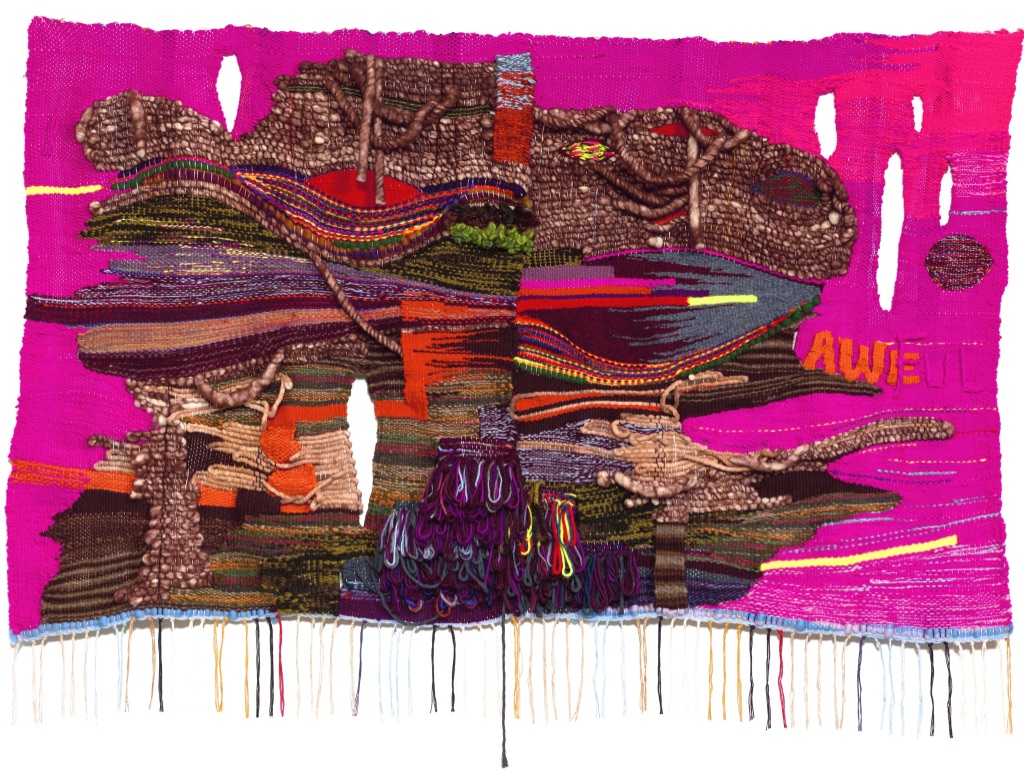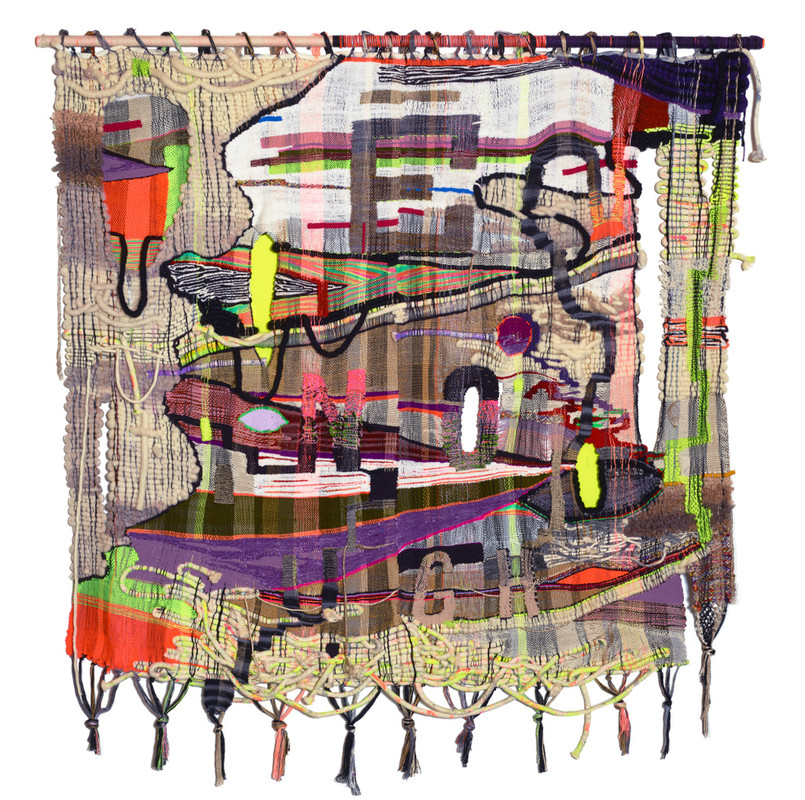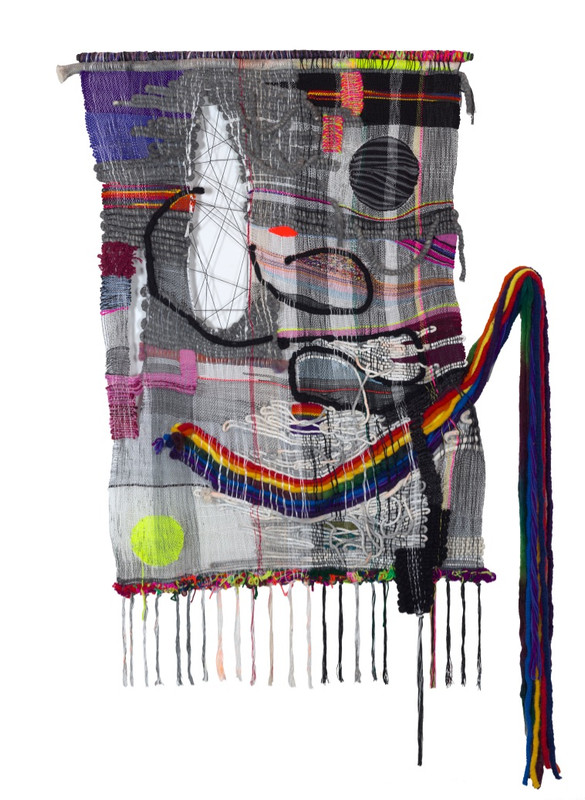
Awe/ful, 2018, wool, acrylic, cotton, metallic fibers, 45 x 64 inches
Terri Friedman’s “Rewire” at Cue Foundation (September 2–29, 2020) directly engages with the psychic reality of our strife-filled current times – but rather than critiquing the subjects at hand, her work delves into the tender drama at play within individual brains and bodies worldwide. Friedman’s woven paintings are abstract, colorful, and multi-textured cross-sections of brains under the spectrum of emotion, with a gentle suggestion to consciously alter the patterns and pathways away from a default of negativity, as she states: “cultivating elevated states and happy hormones is a political and personal weapon against indulging in despair.”
Interview by Brandon Johnson
This body of work is both a sign of the times, and a suggested antidote – to “re-wire” the brain from the current default of angst and worry. Was there any specific event or spark that initiated this series, and over what period of time were the works made?
This series is part of a larger body of work that I have been working on since the last election. I think the national unrest and political volatility sparked my own personal anxiety. My work journals the world around me and my own inner world. I’m wired for worry, but between Climate Change, the national and global uncertainty, racial inequity, the fake news, our President . . . I could go on, I just started feeling despair. My weaving became my medicine. An antidote to all the heartbreak and grief. What if I made protest posters like Sister Corita Kent with words, color, and abstraction. Tapestries that were healing, life affirming, but also agitated yet affirmative screams. Brain and cognitive science has found that the brain, which we assumed was not plastic after childhood is actually able to be rewired. This is neuroplasticity. So rewiring which is actionable is about repair. It’s optimistic.
The suggested connection between neural networks and weaving is made visceral through the variation of textures, sizes, and methods by which the materials are adhered—the end result being an expressive diagram seemingly composed of tissue, vessels, and other bodily matter. For this reason, did your process of weaving feeling extra charged either psychically or physically? How was it to make this works?
That’s such a great question. No one ever asks how it was for me physically or psychically to make this work. It’s actually a very important question. I am so interested in the somatic and psychological experiences of artists. Weaving can be back breaking. Such physical work. But, also immersive and meditative. Sometimes I just lose track of time. The repetition kind of puts me in a trance state. Psychically it was exhilarating. I just love working with so many textures, fiber, and colors. It is like a fiber orgy. I have accumulated so many clear tupperware boxes filled of colored fibers the past years. All kinds from naturally dyed wool to cotton piping which I paint with acrylic paint to metallic to acrylic to hemp and more. I draw out the piece ahead of time with diagrams of textures/fibers/colors/warp design and graph it out. Then I select all my fibers and begin. The pre-weaving process is lengthy.
You mentioned Sister Corita Kent as an influence in terms of subject, spirit, and presentation. Are there any specific artists or weaving traditions that have informed your work on a more material level?
I came to textiles late in my career, 2014. I painted and made kinetic sculptures before that. Though the connective thread though all my work has been color, body, breath, and brain. I am most informed by painters/artists (mostly women) who indulge in color and odd materials like Joanne Greenbaum, Sarah Cain, Shara Hughes, Judith Lynhares, Kathy Butterly, Rachel Harrison, Katharina Grosse, Katherine Bradford, Nick Cave, Polly Apfelbaum, Jeff Gibson, Franz West, and more. Textile artists that I look at are Sheila Hicks, Hannah Ryggen, Josep Grau-Garriga, Anni Albers, Magdalena Abakanwicz, and numerous younger living artists. On a material level, so many artists who stretch materials are interesting to me. I define craft as attention to detail. So, it’s a broad interpretation.

Enough, 2018, wool, cotton, hemp, acrylic, metallic fibers, 77 x 50 inches
Text also appears in these works in the form of single words or short phrases – often slanted toward the negative, such as AWE/FUL, E/NO/UGH, IF ONLY. Did these words arise in your mind organically (almost mirroring their presence in the artworks) or was there a process from which you arrived at them?
The words are more disbelief or antidotes to anxiety: like Pause, Awake, In/hale/ex, and more. they can be either positive or negative. They are ambiguous. AWE-inspiring + awFUL (thus AWE/FUL). ENOUGH connotes ‘stop! enough!’ OR I am ‘good enough’ as I am. IF ONLY is regret, but also kind of romantic, living in the past, kind of naive because it’s done. What good is regret? Just move on and take action now, in the present moment. Awake is a reminder to wake up to the volatility and it’s a call to action. I like small benign or ambiguous words. Words that are spacious and give the viewer a roll in completing. I don’t want to lecture, they are more of a suggestion or direction. They blend in and are almost camouflaged. The words arise at the same time as the drawing. They are like another color or shape. I don’t illustrate the words, but I do try and have the piece emote with color and form what I am feeling. Like the burning pink, so hot and inflamed with ‘Awake’. OR the eye chart and busy anxiety of E/NO/UGH. I like abstraction and words because they feel generous and not didactic. Immersive.

Oxytocin, 2019, wool, acrylic, cotton, hemp, chenile, metallic fibers, 77 x 70 inches
One of my favorites is “Oxytocin” which is composed mainly of shades of gray, with a half-smile of rainbow drooping off the side in a way that is bleakly humorous. There is a certain messiness to these works that communicate a degree of confusion and stress, but the bright colors and titles such as “Looking for what is not wrong” indicate an underlying search for the bright side. Is perseverance part of the thesis of this exhibition?
Oxytocin is a happy hormone like serotonin and dopamine. My titles and palettes do reflect perseverance. Rewiring takes effort but is a positive action. In some ways, this work and the titles are my attempt to rewire my brain for positivity given how dark and bleak the world feels right now. And, they are remedies for the personal and national anxiety and grief. So much loss with COVID, the criminality of our government and more. Humor or delight are very important to me. I had an art history professor in college use the term ‘sickly sweet’ to talk about Chagall’s work. He did not like the work and was disparaging. And, all I could think was ‘I love sickly sweet’.